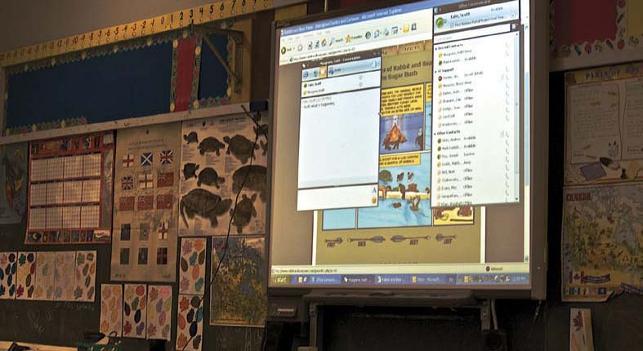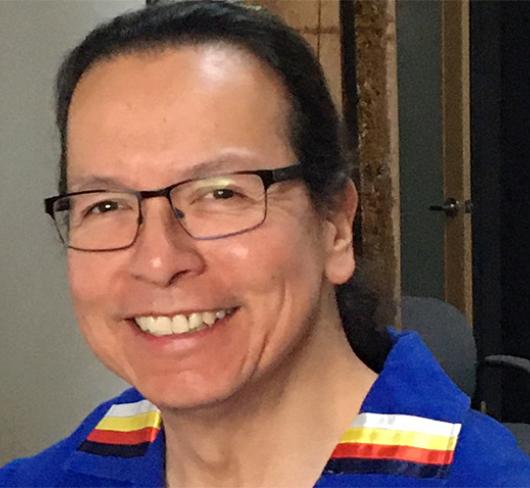
Exploring Traditional Ways Online
The excitement in Max Evans’s class is palpable.
It’s an unusual experience for the children of the First Nations School (FNS) in Toronto’s downtown east end to have a bearskin, with the animal’s head still attached, spread out in their room. At first the kids steal glances at the bear. Gradually, they reach out to touch the fur, the claws, and the teeth, exploring an animal that is part myth, part reality to most of them.
The bearskin has made it to the classroom courtesy of Chad Solomon, a First Nations graphic novelist. Solomon is the author, with Christopher Meyers, of Rabbit and Bear Paws, a comic series that seeks to bridge the growing gap between urban Aboriginal students and their cultural roots. He is at FNS to help the grade 3/4 students write their own graphic story, but he is also reaching out to an audience of students at Eastview Junior Public School, several miles away in Scarborough.
In a highly interactive session, Evans, Solomon, and I encourage the kids to create a story using the tools of the graphic artist – speech bubbles, for example. Solomon works on a Smart Board, drawing the story, as he simultaneously initiates the children into the finer points of graphic art. At the same time, he is webcasting to students of Eastview, where instructional leader Cindy Matthews and grade 4 teacher Alana Brunette are providing support.
Research has shown that students need to be well rested and fed to be ready for learning, but they also need to feel safe and respected in their learning environment. This is particularly true for First Nations students, who are often searching for their identity as urban Aboriginal youths.
In a city as diverse as Toronto, providing urban Aboriginal students with a learning environment that allows them to understand and experience First Nations traditional teachings, cultures, and languages is a challenge. Like other cultural groups, many Aboriginal students are blended into various Toronto schools. However, there is a high First Nations student presence at three schools: First Nations School of Toronto (K-8); Eastview Junior Public School (K-6); and the Native Learning Centre (9-12). Students come to FNS specifically to learn and practise Aboriginal culture, but the 100 Aboriginal students at Eastview are part of a mainstream school that also has 300 non-Aboriginal students.
The interactive session with Chad Solomon was made possible by a technological initiative of the Toronto District School Board, with the support of the Toronto Urban Aboriginal Strategy, Smart Technologies, Dell Canada, and IBM Canada. IBM and the TDSB have built a portal that allows the three schools to connect and expand the use of Smart Boards, so that they become a multimedia instructional tool.
The portal provides students and staff at the three schools with an array of social media: email, Chatterbox, instant messaging, blogs, web conferencing, wikis, voice-over-Internet phones, and shared workspace.
The portal has three unique facets:
- N’odenaawin (My Community) is an Internet meeting space, in some ways similar to Facebook, which allows students to do academic and social networking. Students have the opportunity to work with special guests, and teachers and students from remote sites. In N’odenaawin students can personalize their space with their own avatars, picture files, and links to their friends’ blogs, pictures, and shared assignments. The purpose of networking is to create higher student engagement in learning, to encourage learning about the traditions, cultures and languages of First Nations peoples while enhancing their reading, writing and speaking skills through the use of technology.
- The professional learning community (PLC) component is like the students’ N’odenaawin site. Teachers in First Nations schools often feel isolated. It is difficult to find other teachers with similar situations with whom they can exchange and develop ideas. The PLC enables the teachers in the three schools to connect live by instant messaging, by voice, or by webcam, to exchange information, develop plans, and follow up on their own professional training.
Some of the teachers involved in this initiative are experiencing their first opportunity to work with another teacher of the same grade. They can do lessons together: communications software allows them to see, hear, and control each other’s Smart Boards.
- A curriculum library is being compiled that allows teachers to share best practices and ideas on how to integrate technology with traditional ways and curriculum expectations.
What is the potential of this venture? Use your imagination: with the Web the classroom could easily span Toronto, Ontario, Canada … the globe.

